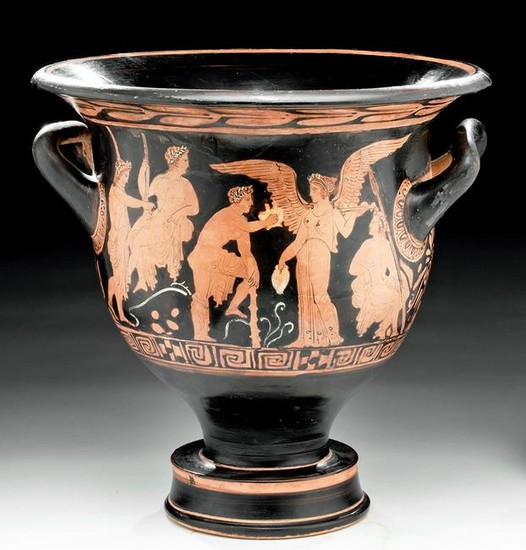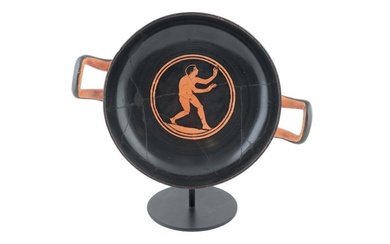Greek Attic Red-Figure Bell Krater w/ Herakles & Nike
Ancient Greece, Athens (Attic), ca. 4th century BCE. A sizeable and very fine bell krater decorated via the red-figure technique. Side A presents a marvelous scene centered on Herakles who is adeptly posed in profile with his left hand placed upon his raised knee while gallantly offering a kantharos in his right hand to Nike. Nike stands in contrapposto with her magnificent wings outspread and faces the legendary hero. She wears a diaphanous chiton and holds a situla and a phiale. The onlookers to the left of Herakles and Nike likely represent Dioscuri - the twin half brothers Castor and Pollux - perhaps holding torches, and to the right is another nude laureate male with a spear. Size: 11.75" W handlespan x 13" H (29.8 cm x 33 cm)
In addition to this marvelous iconography, the artist included an impressive decorative program. Below the rim is a laurel leaf garland. Underscoring the figural imagery is a band of Greek key and checkerboard variant motifs. Finally, complex palmettes adorn the areas beneath the upraised loop handles, and bands of egg-and-dart surround the termini of the handles.
Perhaps the most exciting innovation in Greek vase painting was the red-figure technique, invented in Athens around 525 BCE and beloved by other artists of Magna Graecia. The red-figure technique allowed for much greater flexibility as opposed to the black-figure technique, for now the artist could use a soft, pliable brush rather than a rigid metal graver to delineate interior details, play with the thickness of the lines, as well as build up or dilute glazes to create chromatic effects. The painter would create figures by outlining them in the natural red of the vase, and then enrich these figural forms with black lines to suggest volume, at times perspectival depth, and movement, bringing those silhouettes and their environs to life. Beyond this, fugitive pigments made it possible for the artist to create additional layers of interest and detail as we see in this example.
Provenance: ex-French collection; acquired by current owner at Paris art market in 2007
All items legal to buy/sell under U.S. Statute covering cultural patrimony Code 2600, CHAPTER 14, and are guaranteed to be as described or your money back.
A Certificate of Authenticity will accompany all winning bids.
We ship worldwide to most countries and handle all shipping in-house for your convenience.
#152678 Dimensions: Condition Report: Professionally repaired from multiple pieces with restoration over the break lines and some areas of repainting over the break lines. Expected surface wear commensurate with age. Nice fugitive white pigment remains.
View it on
Estimate
Time, Location
Auction House
Ancient Greece, Athens (Attic), ca. 4th century BCE. A sizeable and very fine bell krater decorated via the red-figure technique. Side A presents a marvelous scene centered on Herakles who is adeptly posed in profile with his left hand placed upon his raised knee while gallantly offering a kantharos in his right hand to Nike. Nike stands in contrapposto with her magnificent wings outspread and faces the legendary hero. She wears a diaphanous chiton and holds a situla and a phiale. The onlookers to the left of Herakles and Nike likely represent Dioscuri - the twin half brothers Castor and Pollux - perhaps holding torches, and to the right is another nude laureate male with a spear. Size: 11.75" W handlespan x 13" H (29.8 cm x 33 cm)
In addition to this marvelous iconography, the artist included an impressive decorative program. Below the rim is a laurel leaf garland. Underscoring the figural imagery is a band of Greek key and checkerboard variant motifs. Finally, complex palmettes adorn the areas beneath the upraised loop handles, and bands of egg-and-dart surround the termini of the handles.
Perhaps the most exciting innovation in Greek vase painting was the red-figure technique, invented in Athens around 525 BCE and beloved by other artists of Magna Graecia. The red-figure technique allowed for much greater flexibility as opposed to the black-figure technique, for now the artist could use a soft, pliable brush rather than a rigid metal graver to delineate interior details, play with the thickness of the lines, as well as build up or dilute glazes to create chromatic effects. The painter would create figures by outlining them in the natural red of the vase, and then enrich these figural forms with black lines to suggest volume, at times perspectival depth, and movement, bringing those silhouettes and their environs to life. Beyond this, fugitive pigments made it possible for the artist to create additional layers of interest and detail as we see in this example.
Provenance: ex-French collection; acquired by current owner at Paris art market in 2007
All items legal to buy/sell under U.S. Statute covering cultural patrimony Code 2600, CHAPTER 14, and are guaranteed to be as described or your money back.
A Certificate of Authenticity will accompany all winning bids.
We ship worldwide to most countries and handle all shipping in-house for your convenience.
#152678 Dimensions: Condition Report: Professionally repaired from multiple pieces with restoration over the break lines and some areas of repainting over the break lines. Expected surface wear commensurate with age. Nice fugitive white pigment remains.




